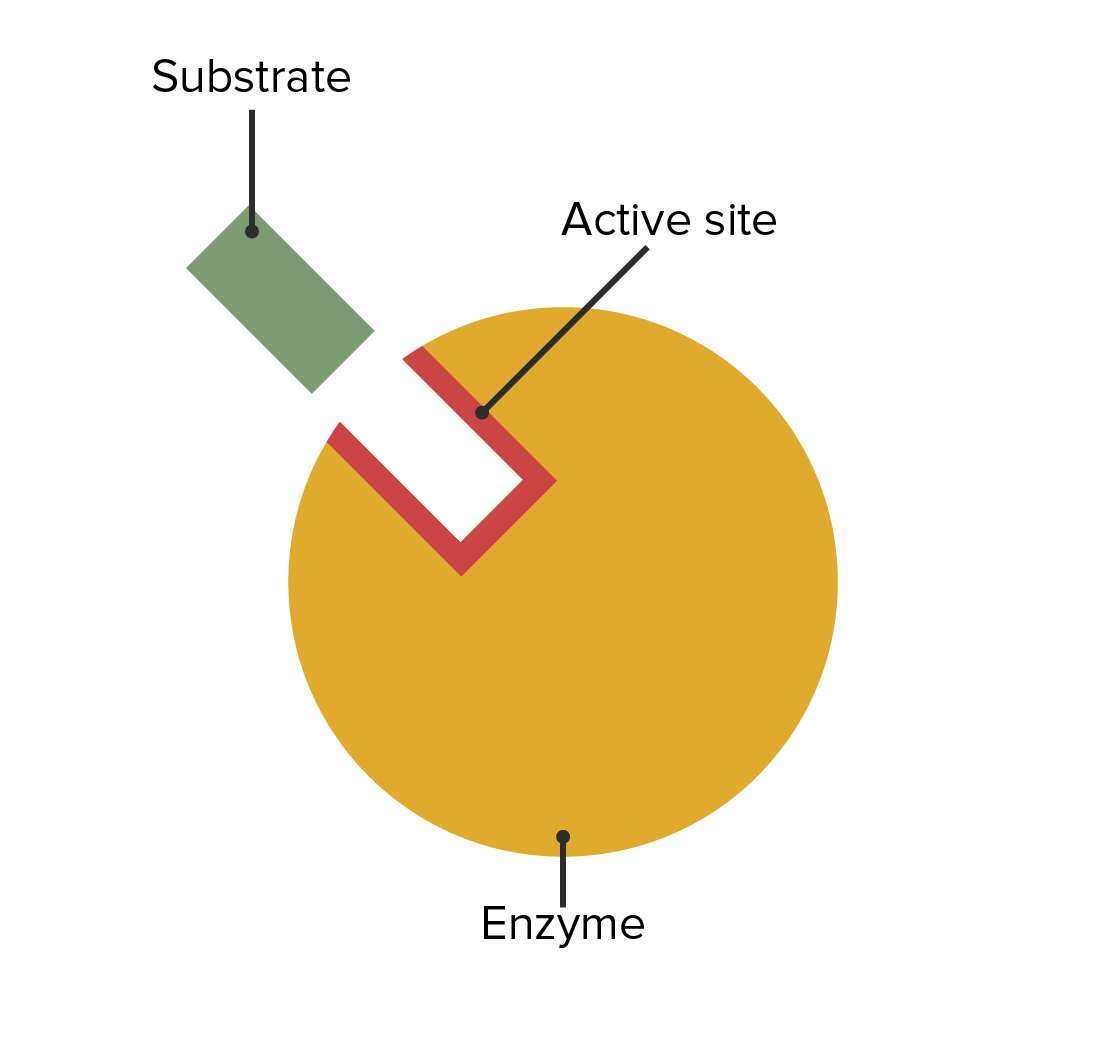Playlist
Show Playlist
Hide Playlist
Allosteric Binding – Enzymes
-
Slides 11 Chemistry Advanced Le Gresley.pdf
-
Download Lecture Overview
00:01 So, let’s have a look at an example. Here we have our enzyme, shown in green, and we have our substrate, shown in blue. Obviously, under normal circumstances, binding would occur, a reaction would occur and then the products of that enzyme catalysed reaction would be released. 00:17 Here we have an example inhibitor, shown as a red rectangle. Instead of directly attacking the active site, which is what we have seen in the past, this inhibitor is shown to be antagonising a allosteric site. 00:34 Note how the shape of the active site is now changed in our cartoon, gone from being the same shape as the substrate or half of the substrate to being substantially smaller. 00:43 The change in the shape of the active site thus prevents the substrate from binding successfully and prevents the reaction from taking place. 00:52 A good example of some of these would be in the case of the non-nucleoside reverse transcriptase inhibitors used in the treatment of HIV, for example, nevirapine. Because the inhibitor binds at the allosteric site, the active site changes shape and the substrate can no longer bind. 01:14 The inhibition, however, is reversible because the inhibitor is not permanently bound at the allosteric site and again, would be reliant upon the type of intermolecular forces, which we have discussed before: weak intermolecular forces, dipole-dipole or ion-dipole, for example. 01:32 The binding is, therefore, an equilibrium, as we saw when we were talking about reversible inhibition. If the concentration of the inhibitor drops, then the enzyme is less likely to be bound to it and the enzyme activity will, as a consequence, increase. 01:48 So, let’s have a look at irreversible enzyme. And I was talking about salicylic acid and aspirin earlier on. Aspirin in of itself is actually a pro-drug for the active salicylic acid shown here. 02:01 Remember what we said, pro-drugs are often esters and here, you can see that we have an ester group attached to a benzene ring, attached to a carboxylic acid group. And in this particular case, the aspirin ester group is hydrolysed and salicylic acid is the result. 02:24 What I’d like you to do is to consider what type of metabolic transformation converts the aspirin to the salicylic acid and how much you draw out the mechanism of that. 02:33 So, now, let’s quickly have a quick look at the biological role of aspirin, since we have discussed it. It’s so important. Irreversible inhibition of cyclooxygenase-1 is responsible for reducing the amount of arachidonic acid derivative, PGG, which is part of the inflammatory cascade found within, for example, the human body. 02:57 Cyclooxygenase, otherwise known as prostaglandins synthase, is important in the body for the biosynthesis of prostaglandins which are responsible for pain and inflammation, as I have said. 03:08 In the middle of the screen, you can see one of the precursors to these prostaglandins known as arachidonic acid and what cyclooxygenase does, as you can see, is it's responsible for the catalytic oxidation of specific sides around that arachidonic acid. By inhibiting the action of this enzyme, you can reduce the amount of prostaglandin, thus reducing the inflammatory marker and reducing, therefore, pain as a consequence. 03:36 Now we've discussed enzymes, we are now going to be looking more at the pharmacodynamics and pharmacokinetics and then after this, we will be moving onto pro-drug design and also a short example of beta-lactam antibiotics and derivatives of those.
About the Lecture
The lecture Allosteric Binding – Enzymes by Adam Le Gresley, PhD is from the course Medical Chemistry.
Included Quiz Questions
Do allosteric inhibitors typically target the active site of an enzyme?
- No. They influence the shape of an enzyme by binding to a region other than the active site.
- Yes.
Which of the following best describes an allosteric inhibitor?
- An allosteric inhibitor binds to an allosteric site and brings conformational change to prevent substrate binding at the active site.
- An allosteric inhibitor needs a cofactor to block the active site of an enzyme molecule.
- An allosteric inhibitor directs the binding of a substrate molecule to the allosteric site of an enzyme instead of the active site.
- An allosteric inhibitor occupies both allosteric and active sites of an enzyme molecule to prevent the substrate binding to the active site.
- An allosteric inhibitor facilitates the binding of a cofactor to the active site of an enzyme.
Which of the following is NOT true regarding Nevirapine?
- Nevirapine inhibits the synthesis of viral DNA by blocking the movement of DNA polymerase on the parental DNA strand.
- Nevirapine is a non-nucleoside reverse transcriptase inhibitor.
- Nevirapine is an antiretroviral medicine used in the treatment of HIV/AIDS.
- Nevirapine brings the conformation changes in the active site of the viral transcriptase enzyme by binding at a hydrophobic pocket away from the active site.
- Nevirapine is an example of allosteric inhibitors.
The active form of aspirin helps to manage pain and inflammation in what way?
- By indirectly preventing the synthesis of prostaglandins through inhibition of cyclooxygenase enzyme.
- By preventing the release of prostaglandins near the affected areas of wound.
- By activating the synthesis of prostaglandins.
- By facilitating the binding of prostaglandins to the allosteric site of cyclooxygenase enzyme.
- By facilitating the binding of cyclooxygenase enzyme to the substrate for synthesis of prostaglandins.
Customer reviews
5,0 of 5 stars
| 5 Stars |
|
5 |
| 4 Stars |
|
0 |
| 3 Stars |
|
0 |
| 2 Stars |
|
0 |
| 1 Star |
|
0 |




